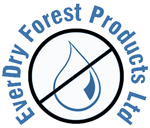DryVac 1010 is currently being used by most of the major manufacturers of wood windows in Canada. DryVac 1010 contains propiconazole, a highly effective yet safe-to-use fungicide, plus a blend of specially selected non-toxic ingredients that impart excellent water repellent qualities without compromising adhesion of water based paints and coatings.
DryVac 1010 is supplied in 18.9L pails, 157kg drums and 800kg tote tanks. It can also be delivered by tanker.
The DryVac 1010 has been specially developed to meet the requirements of the millwork manufacturer. It is easy to apply and does not contain ingredients that cause a reaction with employees who may have sensitive skin or eyes. The product is readily applied by spray, dip or double vacuum.
How DryVac 1010 Protects Wood from Rot and Decay
When wood is treated with Dryvac 1010 it becomes resistant to attack by wood-decaying fungus. This is achieved by a combination of water repellents and a biologically active chemical (propiconazole) that is lethal to many kinds of fungus including those that cause wood decay.It is important to remember that fungus spores can germinate only when there is a certain amount of dampness in the wood. For that reason kiln dried lumber will remain sound indefinitely if stored in dry conditions. However, once the moisture level increases to about 20% the fungus spores will begin to germinate, and if the dampness persists the wood will start to rot. Thus the ingredients of Dryvac 1010 protect the wood in two ways:
1. If the treated wood is exposed to water for a short time, the water repellency constituents prevent the ingress of moisture, so it would take a much longer exposure period for the moisture content to rise above the critical 20% level; and:
2. If it happens that the moisture content does increase above the 20% level, then the fungicidal component, propiconazole, makes the wood toxic to fungus so that growth cannot occur and the wood remains sound.
In other works, milled wooden components that accidently come into contact with water for a short period before they are installed are very unlikely to undergo decay. It is a matter of record that since 1996 when Dryvac 1010 was first introduced to the Canadian window and door sector, there has not been a single reported incidence of failure due to wood decay.
Application of Dryvac 1010
End grain is the zone of a wood component that is most likely to absorb moisture and as a result where decay is most likely to begin. The application process therefore has to concentrate on this particularly vulnerable zone of window sashes, door jambs, etc. A thorough treatment is assured by full immersion process such as a 3 minute dip, or especially by the double vacuum process. Properly designed spray equipment will also achieve this result.
The Dryvac spray system has been designed to ensure that the end grain is treated with copious quantities of Dryvac 1010, so that product migrates several millimetres inside the wood at these vulnerable locations. Wood treated with Dryvac 1010 in properly designed equipment will ensure that the treated wood meets (and exceeds) the CSA A440 standard.
Decay Resistance and Water Repellency Standards
The DryVac 1010 meets the CSA A440-M90 standard for a wood preservative used to treat wood window frames and sashes. The CSA standard has requirements of anti-fungus activity as measured in a soil block test, and its ability to resist swelling when immersed in water (swellometer test).Its fungal resistance and water repellency has been tested in accordance with NWWDA (National Wood Window and Door Association) protocols TM-1 (soil block test) and TM-2 (swellometer test) and has been shown to meet both standards: the water repellency efficiency is over 60%.
Paint Adhesion
The water repellency properties of a millwork treatment must not affect paint adhesion. Wood treated with DryVac 1010 has excellent adhesion both to oil based enamel paints and to water based latex paints. DryVac 1010 meets the CSA A44-M90 paint adhesion standard.Active Ingredient
The active ingredient of DryVac 1010 is 0.5% by weight propiconazole. L-joints treated with solutions at this strength of propiconazole exhibited total resistance to decay after 77 months of exposure in tests being carried out at Saucier, Mississippi, and L-joints treated with one quarter this strength of propiconazole (0.125%) were also indicating good resistance to fungus under conditions that caused severe decay on untreated L-joints.Tests with propiconazole solutions show that it has better long term resistance to fungus attack than competitive products presently on the market. These tests are still on-going.
